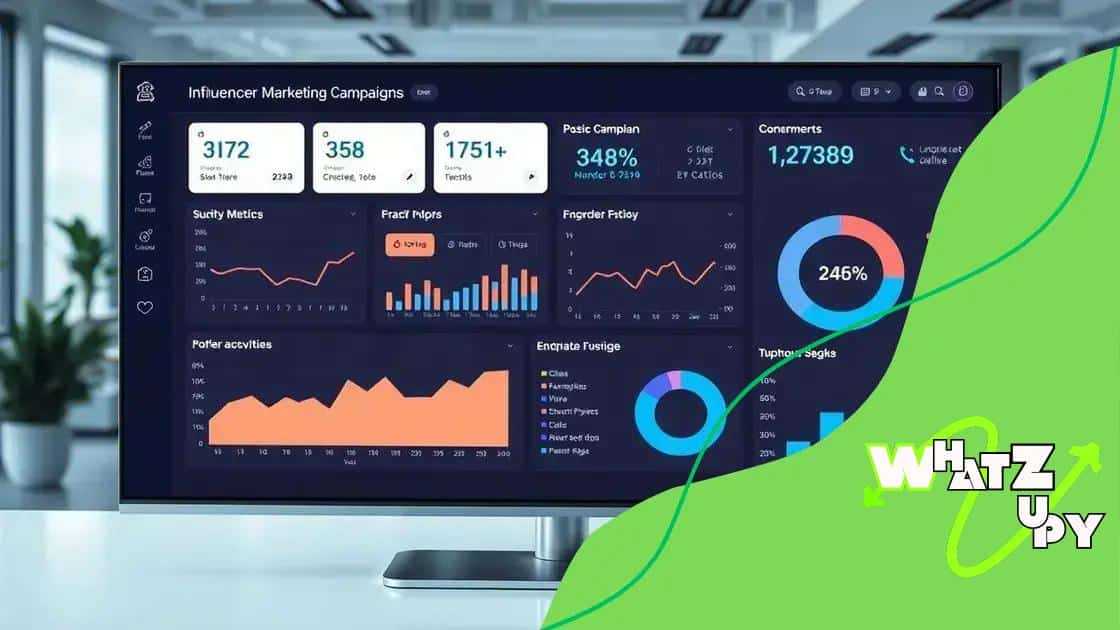Influencer marketing ROI: How to measure real impact

Influencer marketing ROI measures the effectiveness of campaigns by evaluating return on investment through key metrics like engagement, reach, and conversion rates, allowing brands to optimize their strategies for better results.
Influencer marketing ROI plays a vital role in assessing the effectiveness of your campaigns. If you’ve ever wondered how to calculate the true impact of your influencer partnerships, this article breaks down the essential metrics and strategies you need to know.
Understanding influencer marketing ROI
When diving into influencer marketing ROI, it’s essential to understand what it means and why it matters. Tracking this metric can significantly boost your marketing strategies and help you spend your budget more wisely.
What is Influencer Marketing ROI?
Simply put, influencer marketing ROI is a way to evaluate the return on your investment in influencer partnerships. It helps you see if your marketing efforts are paying off.
How to Calculate ROI
To calculate your ROI, you need to take into account several key metrics:
- Revenue generated from campaigns
- Cost of paying influencers
- Engagement levels on posts
- Brand awareness growth measured through surveys
Understanding these elements allows you to gauge the success of your campaigns effectively. For example, if you spent $1,000 on an influencer and earned $5,000 in revenue, your ROI is 400%!
Why ROI Matters in Influencer Marketing
Measuring the ROI of your influencer marketing efforts provides insights into which strategies work best. This understanding allows businesses to:
- Optimize future campaigns
- Choose the right influencers
- Adjust budgets effectively
By grasping the importance of influencer marketing ROI, companies can improve their marketing performance and build stronger partnerships with influencers. It creates a data-driven approach that facilitates better decision-making.
Key metrics to evaluate effectiveness
When evaluating the effectiveness of your influencer marketing campaigns, knowing the right metrics can make all the difference. Key metrics provide insights into overall performance and help refine future strategies.
Important Metrics to Consider
Many brands focus on a few critical metrics to assess their influencer partnerships. Some of the most relevant include:
- Engagement Rate: This measures how much your audience interacts with the influencer’s content. It’s a key indicator of interest and relevance.
- Reach: This indicates how many people have seen the influencer’s post. A wider reach can lead to greater brand awareness.
- Conversion Rate: This tracks how many people took action after seeing the campaign, such as clicking a link or making a purchase.
- Brand Mentions: Monitoring how often your brand is referenced across platforms helps gauge overall sentiment and visibility.
Using these metrics effectively allows marketers to adapt and enhance their campaigns based on real-world data. Tracking engagement rates gives valuable feedback about what resonates with your audience.
Tools for Measuring Effectiveness
There are various tools available that can help track these metrics. Using analytics software tools can simplify the analysis of your influencer campaigns. Platforms like Google Analytics and social media insights provide valuable data.
Additionally, specialized tools like Hootsuite and Sprout Social offer deeper insights into influencer performance. These tools can streamline reporting and allow for easy adjustments based on performance metrics.
By staying informed about your key metrics and the tools available for measuring them, brands can maximize their ROI in influencer marketing and ensure long-term success.
Tools for measuring influencer campaign success

There are several tools available for measuring the success of your influencer marketing campaigns. Utilizing the right tools can help you gather valuable data and insights, ensuring your strategies remain effective.
Popular Tools for Measurement
Some widely used tools include:
- Google Analytics: This tool allows you to track website traffic and understand how visitors interact with your site after engaging with an influencer’s content.
- Hootsuite: Known for its social media management capabilities, Hootsuite also offers analytics features that monitor engagement and reach of influencer posts.
- BuzzSumo: With BuzzSumo, you can analyze the performance of content shared by influencers and see which topics resonate most with audiences.
- Sprout Social: This tool offers in-depth social media analytics, helping you to measure engagement and track brand mentions across platforms.
Choosing the right tools allows marketers to gather data that can enhance future campaigns. For instance, tracking engagement rates through these platforms helps gauge an influencer’s impact.
Integrating Tools into Your Strategy
To make the most out of your measurement tools, integrate them into your overall marketing strategy. Regularly review analytics to fine-tune your approach. Setting clear goals and benchmarks will help assess which influencer partnerships yield the best results.
Using multiple tools can also provide a more comprehensive view of campaign performance. Monitoring different metrics from various sources ensures that no critical data point is overlooked, allowing for a well-rounded analysis of your campaigns.
Case studies: Brands with successful ROI
Exploring case studies of brands that achieved a high return on investment (ROI) from influencer marketing can provide valuable insights. These examples illustrate successful strategies and highlight the potential of influencer collaborations.
Success Stories of Influencer Marketing
Many brands have leveraged influencer partnerships to reach their goals. Here are a few standout examples:
- Daniel Wellington: This watch company grew rapidly by using social media influencers to promote their products. By sending free watches to influencers, they created authentic content that resonated with audiences, resulting in millions in revenue.
- Fiji Water: Fiji Water successfully used influencers during events like the Golden Globes. By gifting their water to influencers and celebrities, they gained unprecedented exposure on social media platforms, significantly boosting brand awareness.
- Gymshark: This fitness apparel brand engaged with fitness influencers to build a community. Their approach focused on genuine relationships rather than paid promotions, leading to a loyal customer base and a considerable increase in sales.
These stories demonstrate that when brands invest in the right influencer marketing strategies, they can achieve remarkable success.
Key Takeaways from Case Studies
Analyzing these successful campaigns reveals important lessons for brands aiming to replicate their achievements. Focus on building authentic relationships with influencers. This authenticity often resonates more with audiences and can drive stronger engagement.
Additionally, tracking the performance of partnerships is crucial. By using analytics tools to measure the effectiveness of influencer campaigns, brands can adjust their strategies and maximize their ROI.
The success of these brands highlights the importance of creativity and strategic planning in influencer marketing, reinforcing the idea that successful campaigns are not just about paying influencers, but creating lasting partnerships.
Strategies to enhance return on investment
Enhancing your return on investment (ROI) in influencer marketing requires strategic planning and execution. By focusing on specific tactics, brands can maximize their results and drive more value from their campaigns.
Establish Clear Goals
Before launching any campaign, it’s essential to set clear and measurable goals. Determine what you want to achieve, whether it’s increasing brand awareness, driving traffic, or boosting sales. Having defined objectives helps you choose the right influencers and tailor your content strategy accordingly.
Choose the Right Influencers
Selecting influencers that align with your brand values is crucial. Look for individuals whose audience matches your target demographic. This alignment increases the chances of successful engagement. Consider micro-influencers as well; they often have highly engaged audiences and lower engagement costs.
- Authenticity: Choose influencers who genuinely love your product to create more relatable content.
- Engagement: Prioritize influencers with high engagement rates over those with just a large following.
- Relevance: Ensure the influencer’s content aligns with your brand identity and messaging.
Engaging the right influencers can significantly improve your campaign performance.
Focus on Quality Content
The content produced during influencer campaigns should be high-quality and authentic. Collaborate with influencers to create engaging and creative posts that resonate with their audience. Encourage storytelling, as it helps build an emotional connection with the product. The goal is to create content that feels organic rather than forced promotional material.
Track and Analyze Performance
Ongoing monitoring of your campaign is essential. Use analytics tools to measure key performance indicators (KPIs) such as engagement, conversions, and reach. Adjust your strategy based on the data to optimize performance. If one influencer drives significant traffic, consider building a long-term partnership for sustained results.
By implementing these strategies, brands can enhance their ROI and maximize the effectiveness of their influencer marketing initiatives.
FAQ – Frequently Asked Questions about Influencer Marketing ROI
What is influencer marketing ROI?
Influencer marketing ROI measures the return on investment from influencer partnerships, helping brands evaluate the effectiveness of their campaigns.
How can I choose the right influencers for my brand?
Select influencers whose audience matches your target demographic and who share similar values with your brand for better engagement.
What metrics should I track to measure campaign success?
Key metrics include engagement rates, reach, conversion rates, and brand mentions to assess the performance of influencer campaigns.
How can I improve my influencer marketing strategies?
Set clear goals, focus on quality content, track performance regularly, and optimize your approach based on data insights.





